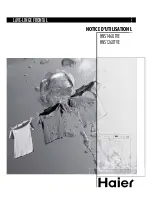
19. Pull the plug from the socket. When not using the electric tool, before maintenance or when changing tools, such as saw
blades, drills and cutting bits.
20. Do not leave any tool keys inserted. Before switching on, check to see that keys and adjustment tools have been
removed.
21. Avoid unintentional activation. When plugging the tool in, make sure that the switch is turned off.
22. Use outdoor extension cords. When outdoors, use only extension cords that are approved and appropriately marked.
23. Be alert. Pay attention to what you do. Approach your work sensibly. Do not use the electric tool when you are distracted.
24. Check the electric tool for damage. Before using the electric tool, you must inspect safety equipment or slightly damaged
parts carefully to ensure that they work properly and as in-tended. Check to see that the moving parts operate freely and
don't stick, and to make sure no parts are damaged. All parts must be mounted properly and meet all the conditions for
ensuring trouble-free operation of the electric tool. Damaged safety equipment and parts must be properly repaired or
replaced by a professional facility, unless otherwise indicated in the user manual. Damaged switches must be replaced by
a customer service facility. Never use an electric tool whose switch cannot be turned on and off.
25. Caution. Using other insertion tools and accessories may cause injury.
26. Have your tool repaired by an electrical expert. This electric tool meets applicable safety requirements. Repairs must be
made only by an electrical expert using original replacement parts. Otherwise accidents many occur.
2 Specific Safety Instructions
2 Specific Safety Instructions
1. The machine shall not be connected directly to the drinking water supply. Short term connection is, however, allowed only
if a anti return flow valve with an aerator is fitted in the inlet pipe, before the machine.
2. Hose lines are to be guided in such a way that they are not pinched or damaged by bodies with sharp edges. Extended
tensile and bending stress to the hose lines is to be avoided.
3. The operator must ensure that the proper condition of the important parts and safety devices is checked every time
before the fluid spray gun is put into operation. Any faults are to be remedied before start-up.
4. For pipe cleaning work do not switch on until the nozzle and the hose are inserted into the pipe until the mark on the
pipe. Please also observe the “Guidelines for fluid spray guns“ and “Safety of electric devices for domestic use and similar
purposes”.
5. Never take in solvent or acid solutions such as paint thinner, petrol, oil or similar fluids. Observe the information provided
by the manufacturers of the additives. The seals in the device are not solvent and acids resistant. The atomised spray of
those solutions is highly inflammable, able to explode and toxic, dangerous in general.
6. This appliance was designed to be used with detergents which are supplied or recommended by the manufacturer. The
use of other detergents or chemicals may compromise the safety of the appliance.
7. The high pressure jet may not be directed at persons, animals, live electrical equipment or at the appliance itself.
8. Do not use the appliance when there are other persons around unless they are also wearing protective clothing.
9. The high-pressure jet must not be directed at other persons or the user him/herself to clean clothing or footwear.
10. Do not spray flammable liquids or other solutions unless specifically allowed by the manufacturer.
11. The machine must not be operated by children or persons who have not been instructed accordingly.
5
MGF
MGF
srl –– Via Chico Mendes, 8 – 43058 Sorbolo Mezzani (PR) Italy – Tel. +39 0521-818301 Fax: +39 0521-818202
E-mail:
–
































